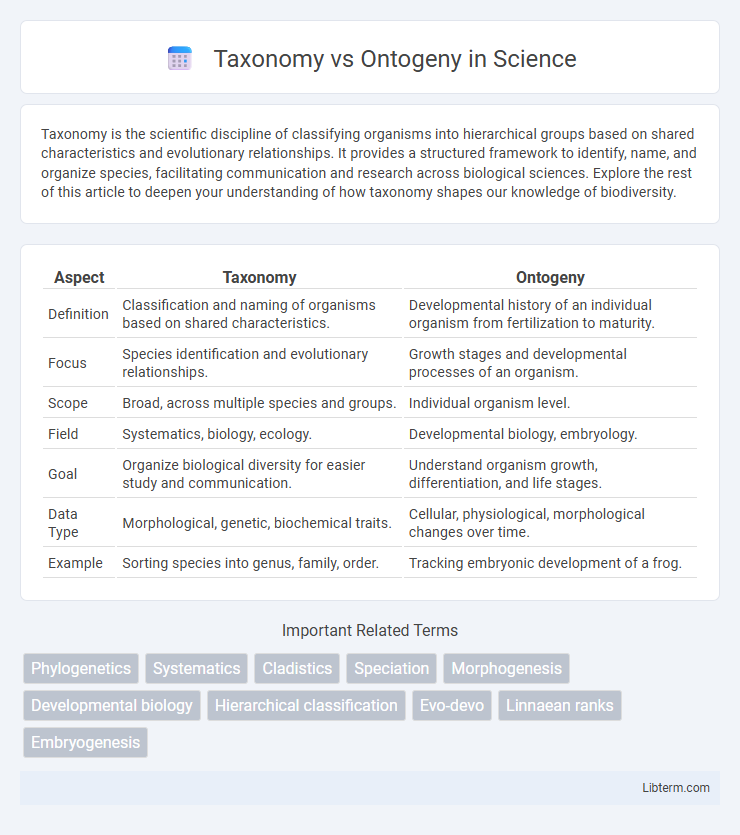Taxonomy is the scientific discipline of classifying organisms into hierarchical groups based on shared characteristics and evolutionary relationships. It provides a structured framework to identify, name, and organize species, facilitating communication and research across biological sciences. Explore the rest of this article to deepen your understanding of how taxonomy shapes our knowledge of biodiversity.
Table of Comparison
| Aspect | Taxonomy | Ontogeny |
|---|---|---|
| Definition | Classification and naming of organisms based on shared characteristics. | Developmental history of an individual organism from fertilization to maturity. |
| Focus | Species identification and evolutionary relationships. | Growth stages and developmental processes of an organism. |
| Scope | Broad, across multiple species and groups. | Individual organism level. |
| Field | Systematics, biology, ecology. | Developmental biology, embryology. |
| Goal | Organize biological diversity for easier study and communication. | Understand organism growth, differentiation, and life stages. |
| Data Type | Morphological, genetic, biochemical traits. | Cellular, physiological, morphological changes over time. |
| Example | Sorting species into genus, family, order. | Tracking embryonic development of a frog. |
Introduction to Taxonomy and Ontogeny
Taxonomy is the scientific discipline concerned with classifying and naming organisms based on shared characteristics and evolutionary relationships. Ontogeny refers to the development of an individual organism from fertilization to maturity, encompassing all life stages and morphological changes. Both fields contribute crucial insights to biology, with taxonomy focusing on organism classification and ontogeny emphasizing growth and developmental processes.
Defining Taxonomy: Structure and Classification
Taxonomy involves the systematic classification and naming of organisms based on shared characteristics and hierarchical relationships, often structured into ranks like kingdom, phylum, class, order, family, genus, and species. It serves as a framework for organizing biological diversity, enabling scientists to identify, compare, and communicate about different species. The emphasis on structural traits and evolutionary lineage underpins taxonomy's role in understanding the natural world's complexity.
Understanding Ontogeny: Development and Growth
Ontogeny encompasses the developmental processes and growth patterns an organism undergoes from conception to maturity, including cellular differentiation and morphogenesis. It provides detailed insights into genetic expression and environmental influences that shape phenotypic traits over time. Understanding ontogeny is crucial for fields such as developmental biology, evolutionary biology, and medicine, as it reveals mechanisms driving organismal complexity and adaptation.
Key Differences Between Taxonomy and Ontogeny
Taxonomy classifies organisms based on shared characteristics and evolutionary relationships, while ontogeny studies an individual organism's developmental stages from embryo to adult. Taxonomy emphasizes grouping species into hierarchical categories such as kingdom, phylum, and genus, whereas ontogeny focuses on biological changes within a single organism's lifespan. The key difference lies in taxonomy addressing species-wide classification and ontogeny addressing individual growth and development processes.
Historical Origins and Evolution of Concepts
Taxonomy, rooted in the 18th century with Carl Linnaeus' binomial nomenclature, established a hierarchical system for classifying organisms based on shared physical traits, shaping biological classification's foundation. Ontogeny, emerging from 19th-century embryological studies by scientists like Ernst Haeckel, explores individual organism development from fertilization to maturity, emphasizing developmental stages and processes. The evolution of these concepts reflects a shift from static classification to dynamic developmental understanding, integrating genetics and molecular biology to refine species relationships and developmental pathways.
Importance of Taxonomy in Biological Sciences
Taxonomy provides a structured classification system essential for identifying, naming, and categorizing living organisms, which facilitates communication and data organization in biological sciences. It enables researchers to understand evolutionary relationships and biodiversity patterns by grouping species based on shared characteristics and genetic information. Accurate taxonomy supports conservation efforts, ecological studies, and advances in biotechnology by ensuring clear species identification and comparison across different biological disciplines.
Role of Ontogeny in Developmental Biology
Ontogeny studies the individual organism's development from fertilization to maturity, revealing how genetic and environmental factors shape growth and differentiation. It provides crucial insights into developmental stages, gene expression patterns, and phenotypic plasticity that drive morphological and functional changes. Understanding ontogeny enables researchers to link genotypic information with developmental processes, enhancing knowledge of organismal biology and evolutionary mechanisms.
Interconnection between Taxonomy and Ontogeny
Taxonomy and ontogeny are interconnected through the evolutionary development of species, where ontogenetic traits provide critical insights into phylogenetic relationships used in taxonomic classification. Studies of embryonic development patterns reveal homologous structures that inform taxonomic hierarchies and evolutionary lineage distinctions. Integrating ontogenetic data allows taxonomists to refine species classification by correlating developmental stages with genetic and morphological divergences.
Applications in Research and Industry
Taxonomy, the classification of organisms based on shared characteristics, is crucial in biodiversity studies, environmental monitoring, and pharmaceutical research for identifying species and understanding ecological relationships. Ontogeny, the developmental history of an organism from embryo to adult, is essential in developmental biology, regenerative medicine, and toxicology for studying gene expression patterns, growth processes, and the impact of environmental factors on organismal development. Research in agriculture benefits from taxonomy for pest control strategies, while ontogeny informs genetic engineering and breeding programs to optimize crop yields and animal husbandry.
Future Perspectives: Bridging Taxonomy and Ontogeny
Future perspectives in bridging taxonomy and ontogeny center on integrating molecular phylogenetics with developmental biology to enhance species classification accuracy. Advances in genomic sequencing and single-cell transcriptomics provide detailed insights into developmental stages, enabling taxonomists to refine evolutionary relationships based on ontogenetic data. This interdisciplinary approach facilitates the construction of dynamic taxonomies that reflect both genetic lineage and developmental processes, improving biodiversity assessment and evolutionary studies.
Taxonomy Infographic

 libterm.com
libterm.com